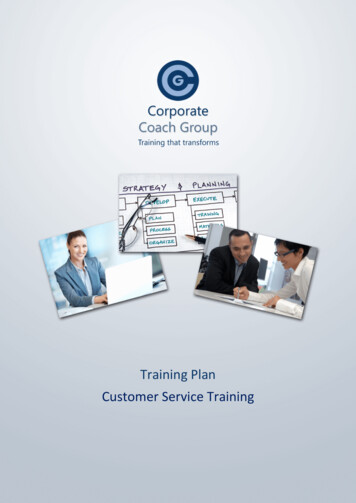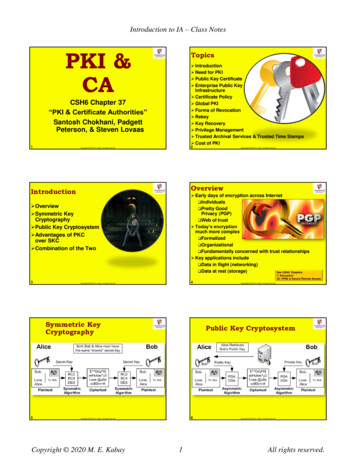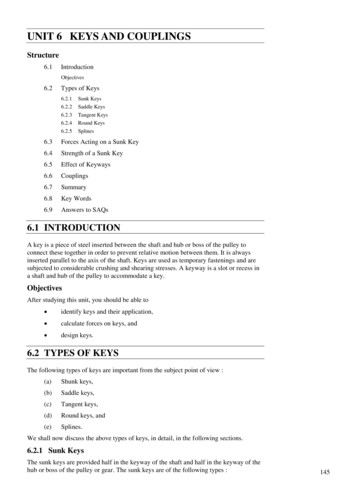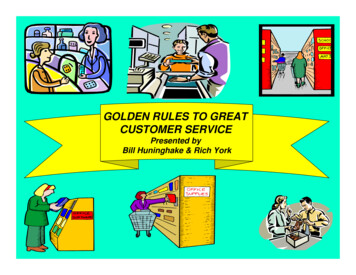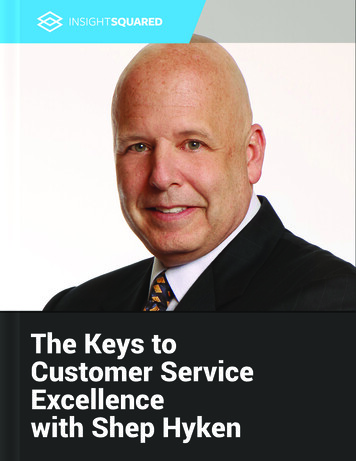
Transcription
The Keys toCustomer ServiceExcellencewith Shep Hyken 1
ContentsIntroductionBuilding Customer LoyaltySummaryCreating Lasting ImpressionsDefining Customer LoyaltyKillers of Customer LoyaltyProviding Excellent Customer ServiceSummaryMaintaining a Standard of Excellence34567891011Exceeding ExpectationsCreating Moments of MagicCustomer Service vs. Customer SuccessCreating a Customer Service CultureSummaryCompany-Wide Buy-InInvesting in Customer ServiceUsing Communication ChannelsSummaryEmail and Social MediaDocumentation and VideoCommunity ForumsMeasuring Success and Tracking PerformanceSummaryMeasuring EffectivenessCustomer 8Contents2
IntroductionToday, providing top-notch customer service is more important than ever.Consumers have high expectations for customer service, no matter the size, nature, orlocation of the business at hand. Whether dealing with a Fortune 500 company or an earlystage startup, customers expect things to go smoothly when they have problems.As a result, providing sub-par or even average customer service will cost you business. Ifyou don’t take care of your current customers, they’ll go to one of your competitors andyou’ll miss out on renewal or repurchasing opportunities. Furthermore, you’ll lose referralsand brand recognition as customers share their negative experiences on social media andonline review sites. That’s a lot of revenue at stake.In order to sustainably run a business today, it’s absolutely critical to provide excellentcustomer service.But what makes customer service excellent?We spoke with industry expert, professional speaker, and New York Times best-selling authorShep Hyken about what exactly customer service teams should be doing in order to meetand exceed the expectations of their customers.In this exclusive interview, Shep highlights the best practices for optimizing the customerexperience. His insights will help you take your customer service team to the next level.With over three decades of experience consulting companies of all shapes and sizes, Shepknows customer service inside and out. Read his tricks of the trade to discover whereyou’re missing out on opportunities and what more you could be doing. In this eBook, we’llcover: Building Customer Loyalty Providing Excellent Customer Service Creating a Customer Service Culture Using Communication Channels Measuring Success and Tracking PerformanceIntroduction3
Chapter // 1BuildingCustomer LoyaltyContents
SummaryProviding excellent customer service and creating loyal customers go hand in hand. Ifyou want to build customer loyalty, you need to first optimize the customer experience. Byresolving problems efficiently and effectively, you establish rapport and build trust with yourcustomers, keeping them coming back to your business.In this chapter, Shep talks about what it takes to create customer loyalty. Some of thetopics covered include: Creating Lasting Impressions Defining Customer Loyalty Killers of Customer LoyaltySummary5
InsightSquared: At the beginning of a relationship with a customer,what should service teams do to get off on the right foot?Shep Hyken: In addition to doing all of the normal managing of touch points and makingsure that each interaction you have is a positive interaction, customer service teams canfocus on the concept of customer success. This means not just helping the customer getwhat they want right now, but helping them so that in the future, they may learn somethingthat would avoid them having to call and get a support call. Customer success is proactivecustomer service.One negative experience could ruin an otherwiseflawless relationship.If you can incorporate the two of them into the same interaction, then you’re helping toensure success. Some companies today are actually – in their marketing materials –showing a video like, “Look how easy this is to use our product.” It serves as a marketingpiece because it does show how easy it is, but it also teaches the customer how to use theproduct before they even buy the product. And then when they get the product, if they can’tfigure it out, they go back to the video that helped make them want to buy the product. Soit’s really cool – it’s a service concept, it’s a marketing concept, and it’s a success conceptall rolled into one.Regarding first and last impressions – Does one matter more thananother? Or are they both equally important?Well, they’re both part of the journey map, and I think they’re equally important – startstrong, end strong. Why start off weak? Why set the tone for anything less than a positiveinteraction? That first impression sets the tone for whatever is to follow, so don’t start offnegative.Building Customer Loyalty6
How can customer service managers justify the costs and effort ittakes to provide excellent customer service?Just the other day, I heard a CMO at a big online retail company say, “Our loyal customersare worth three times more than our regular, average customers.” It went over almosteverybody’s head till it was brought up later on.Now, you’ve got to define what “loyalty” means. In a restaurant, loyalty means comingback on a semi-regular basis, whether it be once a week or once every couple of weeks. Iconsider that to be loyalty, opposed to going to that particular restaurant every time theyneed something to eat – that’s just not reasonable. But take another business for example.If every time I need a particular product, I don’t go anywhere else besides the one companythat always gives me the best service, good pricing, good value, etc., that’s loyalty.Everybody has to define loyalty differently. But if you can determine what a loyal customeris worth versus what a satisfied customer is worth, then there will be a lot more efforttowards creating customer loyalty.Everybody has to define loyalty differently.What’s the key to creating loyal customers?Consistency and predictability. Let’s assume that the product that you sell does what it’ssupposed to do and the people that deliver it and the level of service they give, is a goodservice, as soon as it’s become predictable and it’s consistent and it’s just a little aboveaverage, and again, it’s got to be a little above average all the time, then you have thechance at creating loyalty.Building Customer Loyalty7
What are the killers of customer loyalty?Lack of training and attitudes. A leader has to define what customer service is in thecompany. And if they don’t do an effective job of clearly defining it, the employees won’tknow what it is that they’re supposed to do.The recognition for the service that they deliver is very important. You’ve got to make surethat they’re recognized.When a manager basically says, “Do what I say, not what I do,” they’re incongruent. They’remean and they verbally abuse their employees and then they tell them to go out and benice, then that’s extreme. But can you imagine? That’s done. Where a manager sits thereand tells somebody they’re doing the lousiest job in the world, now go out and be nice. Ithink those are killers.You want to create an engaged workforce that feels fulfilled and exploits each employeefor whatever unique talent they have. If they’re really good at something and you can givesomebody that as part of their job, they’ll perform better.We know for a fact, based on research from many different organizations and companies,that if somebody is really good at something and they’re just allowed to do 10% of it intheir job, they’re far more fulfilled than if they’re doing a job that doesn’t exploit their uniquetalents. So get them fulfilled, exploit them for their unique talents and motivate them to beexcited about what’s coming up for the company.You want to create an engaged workforce thatfeels fulfilled and exploits each employee forwhatever unique talent they have.Building Customer Loyalty8
Chapter // 2Providing ExcellentCustomer ServiceSection 1
SummaryProviding excellent customer service isn’t something you can do once in a while – you needto do it consistently. Meeting and exceeding customer expectations needs to be top-ofmind at all times. If the quality of your service is inconsistent, your customers will not bepleased. Once the bar has been set, lowering it will disappoint customers.In this chapter, Shep dives into the best practices for providing excellent customer service,covering a range of topics, including: Maintaining a Standard of Excellence Exceeding Expectations Creating Moments of Magic Customer Service vs. Customer SuccessSummary10
What can customer service managers do to continually provideexcellent customer service as their teams grow over time?There’s one word: training. It’s getting people on board to start with and then constantlyreinforcing. And that’s where, again, companies sometimes fall short. They think that oncethey’ve taught employees how to do it right and told them to go out and do it, they don’tthink they don’t need to do anything again.Training is not something that you do one time as soon as somebody comes intothe customer support department – it’s ongoing. And sometimes, it’s not a big deal.Sometimes, you only have meetings and spend five, maybe 10 minutes once every week ortwo to say: “Hey, let’s make sure we’re doing a great job. Here’s an example of somebodythat did a great job. Here’s an example of something that went wrong and this is how wefixed it and restored the customer’s confidence.” So it may just be sharing examples ofwhat’s going on. But it’s constantly putting concepts in front of people that are necessaryto deliver a great customer experience.Training is not something that you do one time.it’s ongoing.It’s not that people forget, it’s just that they get into situations or they get veered off course,and maybe they need to be reminded of the things that they need to be doing in order togive and deliver a better customer experience. Because it’s really easy to get sidetracked ordistracted. Even something as simple as how you answer the phone, when you’re in a hurryor you’re impatient, you answer it with a different tone of voice.But instead, look for consistency. You want the experience for the customer to beconsistent and predictable, which means as somebody in the company, you have todeliver a consistent experience, consistent attitude. And if you don’t feel good that day, itdoesn’t matter. You need to step up and recognize that your job is like show business, it’s acommand performance. As soon as I walk on that floor and I’m answering the phone, I’m inbusiness, putting on a show for my customer. So why not make it a great show?Providing Excellent Customer Service11
How can managers consistently exceed the expectations of theiremployees?I call it the “employee golden rule,” which is to treat the people you work with the way youwant the customer to be treated, if not even better. It’s that simple. Recognize that yourpeople are internal customers as well.Treat the people you work with the way you wantthe customer to be treated, if not better.What do the best customer service teams do differently?Some customer service teams aim to solve the customer’s problem and get off the phoneas quickly as possible. That leaves customers satisfied that they got a prompt answerallowing them to move on. However, the best companies will actually work toward buildingthe relationship while at the same time, taking care of the customer. Does it mean spendinga lot of extra time on the phone or whatever channel they’re on? Not necessarily. But it doestake a little bit more nurturing.If somebody calls with a problem, don’t just answer the problem. Answer the questionand deal with the problem. Look at this customer’s profile. What have they called aboutbefore that you might be able to help them with something so they won’t have to callagain? Taking care of it now and spending a little bit more time saves everybody moretime, especially the call center, when they don’t have to deal with the call again from thecustomer, which ultimately means saving them money.Providing Excellent Customer Service12
What are Moments of Magic and why is it critical to create them?Jan Carlson, said years ago that a moment of truth in business is: “anytime the customercomes into contact with any aspect of a business is an opportunity to form an impression.”I have terms for positive and negative moments of truth. The positive ones are Momentsof Magic , above average experiences – not over the top, just consistently above average.The negative ones are Moments of Misery – those are complaints, problems, or issues thatthe customer has. The third, Moments of Mediocrity , are interactions that are average orsatisfactory. Satisfied customers are not your best customers – loyal customers are. How doyou create loyal customers? You give them Moments of Magic .How do you create loyal customers?You give them Moments of Magic.For example, let’s say I walk through a hotel and all the employees are genuinely nice. Theywave at me, they smile at me. Seldom will I walk by an employee that doesn’t engage withme, even at the level of eye contact and a smile. That, over an extended period of time,becomes an above average experience, yet it’s not over the top. Where can we deliver thoseabove average experiences and try to do it all the time, not just some of the time?How can service teams recover from Moments of Misery ?First, recognize that your job is not to just fix the problem, it’s to restore confidence – andthat’s a big difference. Anybody can say, “Okay, let me fix it and then it’s done,” but you wantto get the customer’s confidence restored. There are five steps to making that happen:1. Acknowledge the problem. 2. Apologize to the customer.3. Fix the problem.4. Maintain a positive attitude throughout.5. Act with urgency.Providing Excellent Customer Service13
How can service teams analyze what’s working well for them andlearn how to repeat it?Analytics is one way, feedback from customers is another. Ask your employees what theyhear the biggest problems are and ask them how they’re solving those problems. Then takea look at what the best practices are for resolving those problems. I love when companiesput together a best practice manual, meaning: if this happens, here’s the best way to handlethat. And make sure that people share their examples of how they use this information, toreinforce the validity of it.Do you think the trend of having one customer service team and aseparate customer success team will become mainstream?I think companies already are starting to create proactive service, and they aren’tnecessarily tied. I have a software that I use and as soon as I signed up, they assigneda coach to me. Now, that coach is not part of the customer service team – the coach isbasically a customer success person who’s there to walk me through the product andmakes sure I understand the basics. This cuts down on my frustration as well as thenumber of times I’m going to have to call and ask for help.I think that companies are integrating both. If a customer service person is looking at acustomer’s profile, and doesn’t take a moment to share with the customer how to be moresuccessful with whatever their product is, they are doing that customer a disservice. Yourcustomer success managers may not be as focused on support, but support reps have tobe focused on success as well.Your customer success managers may not be asfocused on support, but support reps have to befocused on success as well.Providing Excellent Customer Service14
Chapter // 3Creating aCustomer ServiceCultureSection 1
SummaryYour customer service reps can’t be the only ones focused on exceeding the expectationsof your customers – it needs to be a company-wide effort. Creating a customer serviceculture at your company will get everyone on the same page regarding your efforts toconsistently delight customers.In chapter three, Shep shares his tips for getting different departments and leadershipinvolved in customer service. The topics addressed include: Company-Wide Buy-In Investing in Customer ServiceSummary16
How does having excellent customer service benefit the entirecompany?Customers that have a good experience want to come back and do business with youagain. The key is that the next time they come back, the time after that, and the time afterthat, it’s a repeated experience. Eventually they don’t react to the experience, they canpredict what the experience is going to be. When a customer is able to predict that theirexperience is going to be positive every time they do business with you, you’re on the wayto creating a loyal customer – not just a satisfied customer.On the flip side, many companies that are very customer-focused tend to be internallyfocused as well, meaning, they manage the internal customer experience – or the employeeexperience – which makes for an engaged workforce, a more fulfilled workforce, and overall,a better company to work for.What can customer service teams do to convince their executives toadopt a customer service culture across the entire business?First of all, it shouldn’t be the customer service team that’s going to leadership and askingfor the adoption of a customer service culture. Instead, it should be the leadership goingout to everybody and saying, “This is what we want to do.”So if the company is broke and the customer service team is saying, “Hey, we need to fixthis,” the easiest way to do that is to say, “Hey, you sit here next to me and listen to howsome of these calls are going. Then we’ll have a meeting to debrief and figure out what wecan do to improve.”Have you ever seen that in action, where leadership spends time onthe frontlines?When I see this in place, I see leaders say, “I want to be on the frontline. I want to get in thetrenches. I want to hear what our customers are saying about us. So let me shadow a callcenter rep. Let me get in the truck and drive around with a salesperson. Let me go out andmake some visits with our team so that I can hear firsthand.” They’re out there in the fieldworking with people, learning firsthand what the customers are saying and doing and howthey react to the product or service that they’re selling.Creating a Customer Service Culture17
Do you think there’s such thing as over-investing in customerservice?I think the smart answer is to say that you can never invest too much in customer service.But anybody that’s looking at the total financial picture will say, “There is an importantbudget item and that is all about customer service, which means training people properly.”It’s hard to tell if you’ve spent too much, but you can definitely know if you’ve spent too little.What are some of the telltale signs that companies aren’t investingenough in their customer service?The simplest one is if someone says, “Hey, I had a bad experience.” The next would be ifsomeone says, “I had an inconsistent experience,” meaning, it was great today and then itwas really bad the next time or it wasn’t as good.How can other departments at a company – like marketing and sales– help out the customer service team?They all need to be working together. Customer service isn’t a department – it’s aphilosophy. Everybody, at some point, somehow impacts the customer.Customer service isn’t a department –it’s a philosophy.Some companies have a chief customer officer or chief experience officer. These people,in these positions, are tasked with not only analyzing data and looking for better ways toimprove service, but also creating a culture that’s focused on the customer.At the end of the day, all departments need to be working together, not as separate, siloeddepartments. They’re all focused on one thing: creating a great experience for customersthat’s going to make them come back and do business with you again. When that happens,the company prospers, there’s job security, there’s longevity, and there’s success – that’swhat it’s all about.Creating a Customer Service Culture18
Chapter // 4UsingCommunicationChannelsSection 1
SummaryIn order to provide top-notch customer service, you need to be where your customersare. It’s all about being in the right place at the right time. Traditionally, that has meantproviding a phone number that customers can call to reach you. Now, customers are onsocial media, on their smartphones, and on your website. In some cases, the best way toresolve problems for customers is allowing them to self-service by reading documentationor watching a video.In chapter four, Shep discusses why communication channels are such an integral piece ofthe puzzle that is customer service excellence. The channels touched on include: Email and Social Media Documentation and Video Community ForumsSummary20
How can customer service reps who communicate primarily throughemail or tickets create Moments of Magic for their customers?You have to manage every interaction, one interaction at a time, one step at a time. You startoff with a strong opening. You deliver what the customer expects. You ask extra questionsto make sure you understand exactly what the customer needs. If you can become proactiveand answer a question that a customer doesn’t even know he or she has yet, that’s evenbetter. Then always end strong. Your first impressions and last impressions are really lastingimpressions.You have to manage every interaction, oneinteraction at a time, one step at a time.Do you think that every company should be using social media tocommunicate with customers? Or does it depend on the company?Every company needs to be where their customers are. If your customers are hanging out insocial media channels and making comments about your company, you need to be there. Ifthe average customer of a company is 85 years old, there’s a pretty good chance that thoseolder generation people aren’t focused on Twitter and Facebook, but you never know.The other day, I was standing in a line and there were two people in front of me. One personused a check to pay for their merchandise, making everybody wait while they wrote thecheck and fumbled with the pen. The other person – same age, both in their 60s – usedApple Pay. In that particular case, it’s like, “Hey, we’ve got to offer both options because ourdemographic is saying and our research is showing that customers at that age are usingboth forms of payment.” You go where your customer is. If your customers are on Pinterest orInstagram and not Twitter and Facebook, well, that’s fine.I was just over in Kuala Lumpur, Malaysia, and we were talking about Twitter and differentsocial media channels. They said that Twitter hasn’t caught on in that part of that world yet,so they don’t put a lot of effort towards Twitter yet. Wait til it’s time. But don’t wait until afterit’s happened – watch the trends, watch where people are going.Using Communication Channels21
Can Moments of Magic be created through documentation?Sure they can. The self-service solution – in a sense – is an easier, more frictionlesssolution than a phone. Customers have to wait on hold, “Push 1 for this, 2 for that,” get to aperson who says, “Hey, I need proof that you’re a customer,” then asks for my name, SocialSecurity number, my first-born child’s name, etc.The self-service solution – in a sense – is an easier,more frictionless solution than a phone.Instead, imagine this: I bought a ping pong table and went to set it up. There were all thesebars, nuts, bolts, and metal pieces that had to go together, and I’m thinking, “This is crazy!I’ve got to call and get some help.”So I called and the call center was closed. But their recording said, “Please go onlineand look at our video-based solutions.” I could actually go on YouTube and put in themanufacturer’s name and model number and pull up a video of exactly how to put this pingpong table together. It was like having an instructor looking over my shoulder. I thought,“Wow, that worked really well.”Do you think the trend of service teams using videos to solveproblems for customers will catch on?It already is. You’re also seeing other self-service solutions. At its basic root, a self-servicesolution is a frequently asked questions page on your website, but you can go far beyondthat with video. You can go even further by crowdsourcing and creating a forum wherecustomers can ask questions and then other customers share their answers.Using Communication Channels22
At its basic root, a self-service solution is afrequently asked questions page on your website,but you can go far beyond that with video.Some companies have a chief customer officer or chief experience officer. These people,in these positions, are tasked with not only analyzing data and looking for better ways toimprove service, but also creating a culture that’s focused on the customer.At the end of the day, all departments need to be working together, not as separate, siloeddepartments. They’re all focused on one thing: creating a great experience for customersthat’s going to make them come back and do business with you again. When that happens,the company prospers, there’s job security, there’s longevity, and there’s success – that’swhat it’s all about.Do you think that support community forums will grow in popularityin the future?In certain industries, they’re definitely catching on, especially in the software industry wherepeople are talking about how they’re creatively coming up with solutions to problems,how they’re using certain items in different ways to the company’s advantage. Hence, theconcept of the user group.Using Communication Channels23
Chapter // 5Measuring Successand TrackingPerformanceSection 1
SummaryYou may think that your team is providing excellent customer service, but at the end ofthe day, that’s up to your customers to judge. By tracking specific metrics and analyzingqualitative feedback from customers in surveys, you can gauge the success of your efforts.This will allow you to identify what’s working well (so you can replicate it) and pinpointareas where you can improve.In the last chapter, Shep talks about the customer service metrics that matter most. Thetopics covered here include: Measuring Effectiveness Customer SurveysSummary25
How do you think customer service teams should measure theireffectiveness?There are different ways to measure effectiveness. The easiest way is to track Net PromoterScore to determine whether or not you’ve done a good enough job to make customerswant to recommend you.Did they get their problem resolved? How many times did they have to call to get itresolved?If you’re looking at a self-service metric, you want to say, “Okay, if we’re sending somebodyto this self-service solution, like a video, how many calls are we getting on that particularproblem after the customer has watched a video?” In other words, is the video working ornot?Everything can be measured. And the old adage is: “You can’t manage what you don’tmeasure.” So look at those measurements and find out what’s working. See what theresponse rate is, the feedback rate. And see how many times customers are calling back forthe same issues.Ask your employees what the top complaints are that customers experience. Once youhave a list of what these are, just take the top two or three and work on those. See what youcan do to eliminate or mitigate them.How important is it for support teams to have a high first contactresolution rate?Paramount. How important is it? That is it. That’s what customers hope for. If they have aquestion, they only want to ask it once.If they have a question, they only want to ask itonce.Measuring Success and Tracking Performance26
How important do you think it is to resolve problems quickly aftergetting back to your customers and have a low handle time?The idea is you want to restore confidence. If you manage get back to customers quickly,you will, in effect, restore that customer’s confidence.What does your ideal survey look like?My ideal survey is as little a hassle to the customer as possible. I know my auto dealershipis very much into getting a perfect score on their surveys. And I recently said, “I’ll be happyto fill out your survey when it doesn’t take me 10 or 15 minutes to do it.” I believe short andsweet is best, which is why I like the Enterprise Rent-A-Car three question survey, whichtakes less than a minute or so. If you have enough customers, you can change up yourquestions and get some different ideas of where things are trending.But at the end of the day, if you make a customer take 15 or 20 minutes to answer a survey,all the goodwill you have created may go away once they realize that you’re taking valuabletime away from them right now.Do you think customers should be surveyed after every interaction?Or randomly? Or quarterly?Ideally, if it’s a customer that keeps on coming back, there should be some consistencyin surveying the customer. Going back to the auto dealership that I do business with .every time I do business with them, they send me a survey. There’s another company thatI do business with – they’re an Internet-based company – and I get a survey from themonce every quarter or so. Sometimes, companies send out surveys annually. I don’t knowif annual is the right timeframe or not . What happens if something is wrong and just lastmonth did the survey? Well, it’s going to be 11 months before you realize that they haven’tcome back. The goal is to get consistent feedback.Are quantitative surveys all that’s needed? Or should companiesprovide a space for customers to leave qualitative feedback?I prefer the latter – having both. You definitely need the quantitative, but if you can get aresponse to the why a customer gave the answer that they did, that gives you a valuableinsights. You can start to look for similarities and trends.Measuring Success and Tracking Performance27
ConclusionCustomer service has changed d
customer service. But what makes customer service excellent? We spoke with industry expert, professional speaker, and New York Times best-selling author Shep Hyken about what exactly customer serv
